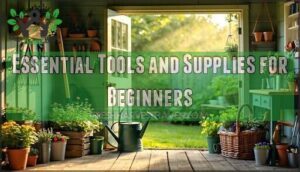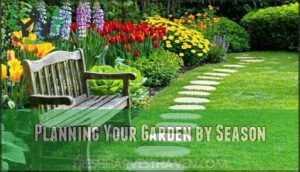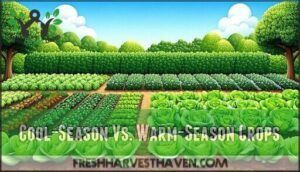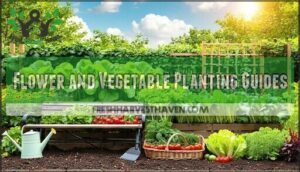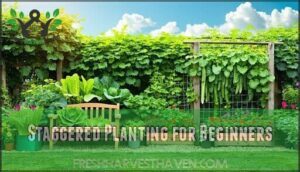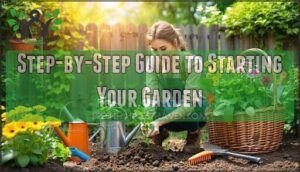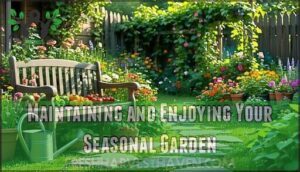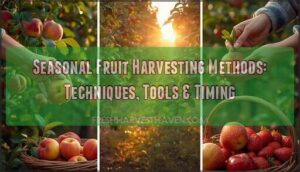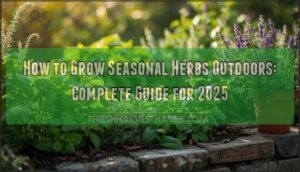This site is supported by our readers. We may earn a commission, at no cost to you, if you purchase through links.
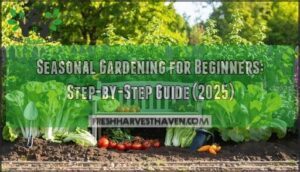 Most gardening advice ignores the seasons—plant, water, and hope for the best. But experienced gardeners know that fighting nature’s calendar is a sure way to watch seedlings wither and tomatoes fail to ripen. Lettuce won’t survive July’s heat, and March-planted peppers will struggle in cold spring nights.
Most gardening advice ignores the seasons—plant, water, and hope for the best. But experienced gardeners know that fighting nature’s calendar is a sure way to watch seedlings wither and tomatoes fail to ripen. Lettuce won’t survive July’s heat, and March-planted peppers will struggle in cold spring nights.
For beginners, seasonal gardening is about working with the weather, planting cool-season crops when it’s chilly and saving heat-lovers for summer. Once you match plants to their seasons, you’ll avoid late frosts and enjoy fresh vegetables year-round.
This guide tells you exactly what to plant when, which tools you really need, and how to prep your soil so each season brings success. You’ll learn to read your garden’s conditions, pick the right crops for each window, and build sustainable practices that keep your beds productive all year.
Table Of Contents
Key Takeaways
- Seasonal gardening works with nature’s calendar by matching cool-season crops like lettuce to spring and fall while saving heat-lovers like tomatoes for summer, eliminating the frustration of fighting wrong temperatures and failed harvests.
- Success starts with assessing your garden’s sunlight exposure, soil quality, and drainage before planting, then using succession planting every two to three weeks to create a steady harvest instead of overwhelming gluts followed by empty weeks.
- Essential beginner tools include pruning shears, a garden fork, and watering solutions like drip irrigation, while soil amendments such as compost and natural fertilizers build the foundation for thriving plants without synthetic overload.
- Crop rotation each season prevents soil depletion and pest buildup, and harvesting at peak times—like picking greens in cool mornings or tomatoes when fully colored but firm—maximizes flavor and encourages continuous production.
What is Seasonal Gardening?
Seasonal gardening is all about working with nature’s calendar, not against it. You plant, tend, and harvest based on what thrives when—cool-season greens in spring and fall, heat-loving tomatoes in summer.
Here’s what you need to know: which plants work best in each season, how temperature and daylight shifts affect your garden, and what tasks to expect as the months roll by.
Definition and Key Concepts
Seasonal gardening isn’t rocket science—it’s just working with nature’s calendar instead of fighting against it. The definition is simple: you plant what thrives when conditions suit its biology. Cool-season crops love spring’s mild temperatures, while warm-season vegetables need summer heat.
It’s a gardening method that works with the seasons instead of against them, which means you’ll waste less time and money on plants that struggle.
Once you get the hang of when to plant what, the whole process starts to feel almost automatic—like your garden’s running on its own internal clock.
How Seasons Affect Plant Growth
Temperature fluctuations drive everything your plants do. Cool-season crops thrive between 65–75°F, while warm-season vegetables need 90–95°F to hit peak growth patterns.
Soil moisture shifts with rainfall, affecting root development and nutrient uptake—too much invites root rot, too little stunts photosynthesis rates. Frost damage remains your biggest seasonal threat, with spring and fall freeze dates determining your entire planting window.
Understanding these forces makes gardening for beginners less guesswork and more garden maintenance success. Additionally, gardeners must consider the impact of climate change effects on plant growth and development.
Examples of Seasonal Activities
Once you know how seasons shape growth, you can plan what to do—and when—to keep your garden productive year-round.
Spring’s when you prep the soil and get cool-season crops in the ground.
Summer means staying on top of watering and celebrating when those tomatoes finally ripen.
Come fall, you’re planting garlic for next year and turning dried flowers into decor.
Winter shifts your focus indoors—planning layouts and starting seeds under grow lights.
In practice, your seasonal garden tasks might look like this:
- Spring: Direct-sow lettuce and peas while hardening off transplants—outdoor activities that align with warming soil temps
- Summer: Mulch heat-loving plants, stake climbing beans, and enjoy nature walks through your thriving rows
- Fall: Plant garlic cloves, collect seeds, and use these gardening suggestions before frost sets in
You won’t master every seasonal rhythm right away—and that’s the point. Start with a few simple tasks, watch what works, then add more as each cycle clicks into place.
Essential Tools and Supplies for Beginners
You can’t grow a thriving garden with just bare hands and good intentions. The right tools make all the difference between a frustrating hobby and a rewarding one that puts fresh food on your table.
So, what do you actually need to get started without wasting money on gear that’ll collect dust in your shed? Let’s take a look.
Must-Have Gardening Tools
You won’t get far without the right tools in your hands—think of them as the difference between wrestling with your garden and working in rhythm with it. Take a look at what you’ll reach for most:
| Tool | Why You Need It |
|---|---|
| Pruning Shears | Shapes plants and removes dead growth cleanly |
| Garden Fork | Loosens compacted soil without destroying structure |
| Rake Tools | Levels beds and gathers debris efficiently |
Gloves keep your hands safe while you work, and a good watering can puts water exactly where it needs to go.
Master these basics and you’ll move from hoping things work out to knowing they will—that’s what makes the difference between struggling through the seasons and staying ahead of your garden’s needs.
Recommended Soil Amendments and Fertilizers
Healthy soil doesn’t just happen—it’s something you build, one amendment at a time. The right additions can make all the difference between plants that survive and those that thrive. Soil preparation for seasonal gardening starts with understanding soil pH and what your plants need.
Here are three essentials for plant care and maintenance:
- Compost and organic mulch – Feed microbial life and improve structure naturally
- Natural fertilizers – Deliver nutrients without synthetic overload
- Microbial supplements and compost tea – Boost beneficial organisms for successful garden maintenance
Watering Solutions and Accessories
Smart watering isn’t about constant attention—it’s about choosing the right tools that let you step back and trust the system. Drip irrigation and soil moisture meters offer water conservation while simplifying garden maintenance and care. Rain barrels promote sustainable gardening, and sprinkler systems handle larger plots efficiently.
| Watering System | Best For |
|---|---|
| Drip irrigation | Raised beds, vegetables, water conservation |
| Soaker hoses | Row crops, targeted watering |
| Rain barrels | Eco-conscious beginners, cost savings |
| Adjustable sprinklers | Lawns, expansive flower beds |
| Moisture meters | Preventing overwatering, gardening advice |
Planning Your Garden by Season
Before grabbing any seed packets, take stock of your garden’s conditions. Three key factors will make or break your success: sunlight exposure, soil type, and drainage.
Here’s what you need to know to pick the right plants and keep your garden producing all year long.
Assessing Sunlight, Soil, and Drainage
Before you drop a single seed in the ground, your garden’s foundation—sunlight, soil quality, and drainage—will either set you up for a thriving harvest or leave you troubleshooting all season long.
Start your site assessment by tracking sunlight patterns throughout the day; most vegetables demand six to eight hours of direct sun. Test your soil composition with a simple squeeze test—it should crumble, not clump.
Poor drainage? You’ll need raised beds or amended soil before planting.
Choosing The Right Garden Location
Once you’ve nailed down those site basics, the real magic happens when you match your garden’s placement to your daily routine and long-term goals.
Your garden layout depends on several practical factors:
- Sunlight exposure shifts with seasons—track winter shadows before committing
- Drainage systems matter more than soil quality in wet climates
- Wind protection from fences or shrubs shields young transplants
- Kitchen proximity makes garden maintenance easier for beginners
- USDA plant hardiness zone determines your seasonal gardening calendar
Smart garden planning and design saves countless hours later.
Designing for Continuous Harvest
Succession planting transforms your garden into a production line, allowing you to harvest for up to 10 weeks straight by planting crops every two weeks. This method eliminates the feast-or-famine cycle of drowning in zucchini one week and having nothing the next. Crop rotation and spatial optimization through companion planting further enhance your garden by preventing soil depletion and boosting yields.
Here’s your scheduling framework to keep harvests coming:
| Planting Strategy | Timeline | Beginner Crops |
|---|---|---|
| Early spring succession | Every 14 days | Lettuce, radishes, peas |
| Summer stagger | 2–3 week intervals | Beans, cucumbers, tomatoes |
| Fall rotation | 3–5 year cycle | Brassicas, root crops, legumes |
| Year-round planning | Quarterly mapping | Mixed cool/warm varieties |
Understanding continuous harvest techniques, such as soil temperature management, is crucial for a successful garden. Documenting planting dates in your vegetable gardening efforts can increase your continuous harvest rate by 15–20%. This simple habit from a gardening for beginners guide transforms random hope into reliable garden planning and design mastery, ensuring true seasonal gardening success.
What to Plant Each Season
Knowing when to plant what can make all the difference between a thriving garden and a disappointing one. It’s not just about picking plants you like—it’s about matching them to the right season so they can grow strong and produce well.
We’ll look at which crops fit each season and how to get your planting schedule right.
Cool-Season Vs. Warm-Season Crops
Understanding the difference between cool-season and warm-season crops is your foundation for smart garden planning. Cool-season vegetables like lettuce, spinach, and carrots thrive when air temperatures hover between 40–75°F and tolerate frost, while warm-season crops—tomatoes, peppers, cucumbers—demand consistent warmth above 65°F and die back at the first freeze.
Soil temperature matters just as much: cool-season seeds germinate at 40°F, but warm-season varieties won’t budge until the ground hits 60°F.
Mastering frost tolerance and seasonal yield patterns through strategic crop rotation transforms your vegetable gardening from guesswork into confident, year-round success—whether you’re spring gardening with peas or winter gardening with hardy greens.
Flower and Vegetable Planting Guides
Now that you know when to plant, the next step is matching specific varieties to your local frost dates and growing zone. A spring lettuce that bolts in May won’t give you the same harvest as one bred for slow-bolting through June heat.
Use planting season guides tied to your USDA zone for accurate plant scheduling. Then, tailor your garden layout and soil preparation around crop rotation principles. Alternating heavy feeders like tomatoes with nitrogen-fixing beans keeps your vegetable gardening productive year after year without depleting nutrients.
Staggered Planting for Beginners
If you want a steady supply of lettuce, beans, or carrots instead of one big harvest that floods your kitchen in July, planting small batches every two to three weeks is the move. This succession planting technique keeps your garden scheduling simple and your harvest planning realistic when you’re starting a garden.
- Plant short rows or clusters every 14–21 days from spring through early summer
- Track your seed starting dates in a notebook or garden app to stay on schedule
- Rotate crop families between plantings to maintain soil health and avoid pest buildup
- Adjust timing based on your gardening year—warmer zones can extend planting season into fall
Step-by-Step Guide to Starting Your Garden
Getting your hands dirty is easier than you might think. Once you’ve finalized your garden plan and chosen your plants, the real work begins—but it’s the kind of work that rewards you with every sprout pushing through the soil.
Here’s your roadmap for turning that patch of earth into a flourishing garden.
Preparing Soil for Planting
Your soil’s quality can make or break your entire growing season—but getting it right doesn’t need a chemistry degree. Start with soil testing to understand pH needs, then add organic matter like compost to improve fertility.
Here’s your seasonal garden planning guide:
| Task | Spring/Fall | Summer |
|---|---|---|
| Soil Testing | Test pH 2–4 weeks before planting | Retest mid-season if plants show issues |
| Compost Creation | Layer brown/green materials in a 3:1 ratio | Turn pile weekly in hot weather |
| Fertilizer Selection | Use slow-release organic blends | Side-dress with nitrogen-rich options |
| pH Balancing | Add lime (raise) or sulfur (lower) | Monitor with simple test strips |
| Organic Matter | Mix in 2–3 inches of finished compost | Mulch surface to retain moisture |
Following these steps gives you a solid starting point, especially if you’re new to gardening and want plants that actually thrive.
Selecting Seeds and Transplants
With your soil ready, the next decision is key: choosing between seeds and transplants. This choice affects your timeline, budget, and early-season workload.
Seeds are cheaper and offer more variety from catalogs, but transplants give you a head start when the growing season is short.
Match your seed choices to your crop rotation plan, and make sure to harden off transplants before planting. This prevents shock and keeps your garden on track, especially for beginners.
Planting, Watering, and Fertilizing Basics
Getting these three basics right—planting depth, watering rhythm, and feeding schedule—can make or break your first season. Plant seeds twice as deep as their width, water deeply but less often to build strong roots, and fertilize based on what your soil actually needs.
Master these three fundamentals—planting depth, watering rhythm, and feeding schedule—and you’ll set yourself up for a successful first season.
Especially as you’re learning which plants thrive in your garden and how to care for them properly.
Using Organic and Sustainable Practices
Switching to organic methods isn’t about flawlessness—it’s about nurturing a garden where the soil and plants thrive together.
Begin with composting kitchen scraps to enrich the soil, use natural pest control like companion planting, and adopt eco-friendly soil conservation practices.
When you use these organic methods, you’re building an ecosystem where everything works better together—and you’ll pick up the natural rhythms of each season as you go.
Maintaining and Enjoying Your Seasonal Garden
Getting your garden planted is just the start—the real magic happens when you nurture it through the season.
Knowing how to care for your plants, harvest at the perfect time, and develop sustainable habits will turn your garden into a lasting source of fresh food and joy.
Let’s look at what it takes to keep everything healthy and productive.
Regular Garden Care and Troubleshooting
Once your garden’s up and running, staying ahead of problems beats playing catch-up every time. Check soil moisture with your finger before watering—most plants need about an inch weekly, delivered deeply once or twice to build drought resilience.
Watch for common pests like aphids and cabbage worms during morning walkthroughs, removing them by hand or using targeted organic solutions. Pull weeds promptly before they set seed, and practice crop rotation each season to prevent soil depletion and disease buildup.
Garden sanitation matters: clear debris and spent plants to reduce overwintering pests, keeping your space healthy without constant intervention.
Harvesting Tips for Peak Freshness
Timing your harvest right can mean the difference between bland, bitter greens and vegetables that taste like they came from a farm stand at dawn.
Here’s what makes the biggest difference in garden yield and produce quality:
- Pick leafy greens in cool morning hours before heat builds bitterness
- Harvest tomatoes when fully colored but still firm for peak flavor
- Cut beans and cucumbers every 2-3 days to encourage continuous production
- Check root vegetables by gently uncovering soil to gauge size
Follow these simple steps, and you’ll get vegetables with better flavor and higher nutritional value from your garden.
Sustainable Practices for Year-Round Success
Creating a garden that flourishes year after year isn’t about doing more work—it’s about working smarter with nature. Rotate crops each season to preserve nutrients, layer compost for soil conservation, and mulch around plants for eco-friendly water management.
This approach cuts down on work while giving you better results, especially if you’re new to planning and designing a garden.
Frequently Asked Questions (FAQs)
How do I protect plants from frost damage?
Before winter’s chill strikes, shield tender plants with frost blankets, cold frames, or mulch insulation. Cover foliage in late afternoon and remove covers once temperatures rise.
With just a few protective steps, you’ll safeguard your plants and maintain a healthy garden even when freezing weather hits.
What pests affect seasonal vegetable gardens most?
Aphids, slugs, and caterpillars are common pests in most seasonal gardens. Spring gardening often brings aphid control challenges, while summer gardening requires managing pests like hornworms and beetles.
Organic methods, such as companion planting, provide effective crop protection without the use of harsh chemicals.
Can I grow vegetables in containers year-round?
Imagine transforming a tiny balcony into your own year-round market—container gardening makes it possible.
You can grow vegetables in containers throughout the year by choosing seasonal crops, relocating pots indoors during cold months, and using grow lights for consistent indoor growing and vertical farming success.
How often should I rotate crop locations?
Rotate your crops every year—move each plant family to a fresh raised bed or garden spot.
This simple garden planning strategy protects soil health, disrupts pest control cycles, and maximizes yield optimization through companion planting benefits that seasonal gardening for beginners often overlooks.
When should I start seeds indoors?
Start most seeds indoors six to eight weeks before your last spring frost date.
Check seed catalogues for specific germination rates and indoor lighting needs—warm-season crops like tomatoes need higher soil temperature than cool-season greens.
Conclusion
Imagine harvesting sun-kissed tomatoes in August, crisp lettuce in October, and tender peas next spring—all from the same garden bed. Seasonal gardening for beginners isn’t about mastering complex techniques; it’s about tuning into what each season offers and planting accordingly.
You’ve learned when to start seeds, which crops thrive in heat or cold, and how to prepare soil that nourishes growth year-round. Now it’s your turn to ditch the guesswork, trust the calendar, and watch your garden flourish with fresh harvests every season.
- https://raleighrealty.com/blog/gardening-statistics-trends
- https://petruslandscape.com/gardening-statistics-in-2025/
- https://www.youtube.com/watch?v=rLQpT0VoHr4
- https://www.reddit.com/r/gardening/comments/1bkhsku/just_curious_after_your_initial_setup_costs_for/
- https://www.vegetableacademy.com/post/how-much-money-is-a-vegetable-garden-worth

